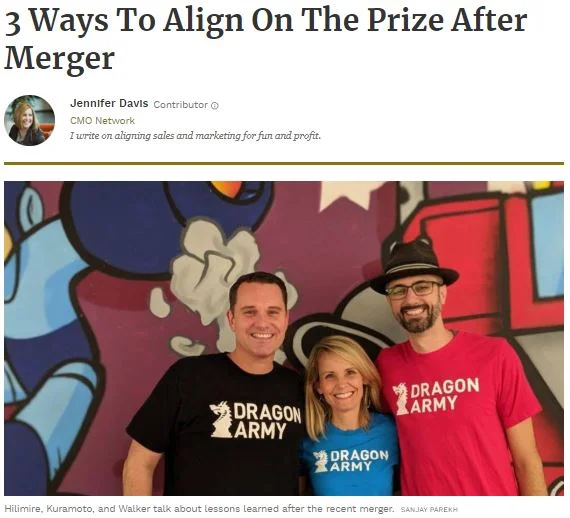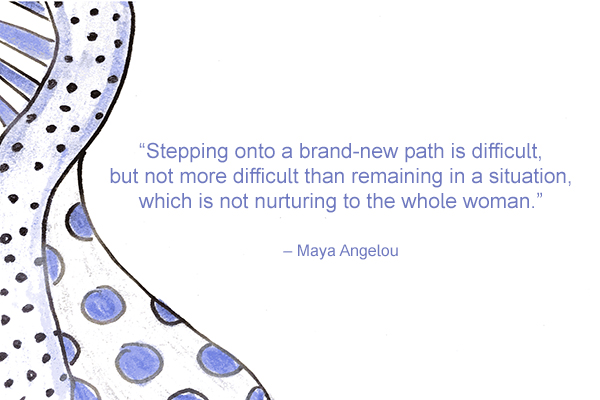“No person is your friend who demands your silence, or denies your right to grow.” – Alice Walker
Viewing entries tagged
Growth
“Finding fault is a pathology.” – John Gottman
Jeff Hilimire and his marketing agency, Dragon Army, knows something about change. The firm had already earned the distinction of the fastest growing agency in Atlanta for the years 2016-2018, when Jeff and his management team considered acquiring two new agencies, at the same time. Watchword, a branding firm founded by Rachelle Kuramoto, and Atlanta web design agency Sideways8, led by Adam Walker, were established and well-respected when they joined forces with Dragon Army earlier this year. The three of them talk about how they maintained cultural alignment and customer-centricity amidst change.
Weave a Culture that Works
The first and last thing to consider in a merger or acquisition is company culture and this one benefited from familiarity and respect. “The three of us had gotten to know one another over a number of years collaborating on client and philanthropic efforts,” said Kuramoto. “Our values and respect for one another have formed the connective tissue during this process.” This was illustrated in their integration process and in the results to date. “We started by making sure the leaders at the top of each organization fit the company culture,” recalled Walker. Once that was established, then leadership teams and all of the employee base was considered. “In the end, it was an amazing fit all around and the merging of the companies has been very smooth,” he said. But smooth integration after a merger comes with a lot of work.
Finding the initial common ground required a look at the company values and leadership styles. Hilimire speaks often about PVTV, which stands for Purpose, Vision, Tenets, and Values, a series of guiding principles and guardrails that he outlines in his recent business fable book “The 5-Day Turnaround.” Hilimire describes two of Dragon Army’s values as “team first” and “think positively.” These combine to create a powerful recipe for positive change management when team members are “able to accept the changes, see the path forward, and encourage other teammates to see the way through in a productive way.” Regularly pointing employees back to the PVTV “continues to guide us and shepherd us through the transition,” Hilimire notes. They serve to “remind people how to behave and work together.”
Kuramoto said that they “spent a lot of time ahead of the acquisition giving people a chance to know each other” in order to begin the endeavor with strong relationships, even with people who were remote. Making choices about what to do next was made clearer with leadership alignment. Kuramoto said they “put a lot of rigor into when, how, and why we meet at leadership, and much of that time has been focused on prioritizing, setting objectives, and staying on track.”
Take Away:
Spend time on the purpose and values of the company. When adopted at all levels and across all locations they will help to do the work of alignment.
Practice Change
Walker noted that the leadership style and structure across all three companies had not been overly hierarchical which helped prepare the organizations for change. “We embrace a node leadership structure with coaches leading teams of people.” The teams are dynamic allowing them to “flex and bend, but also scale, as needed.” Kuramoto noted that paying attention to each other during the merger and now in operating mode requires some regular practices. “As an expanded team, we do many things to attune to one another as people, from a weekly huddle during which we discuss every important detail and allow for questions to highly agile processes. From Slack channels like #nodumbquestions to regular team round tables dedicating to articulating what’s making people happy, challenged, and available to one another.” Walker credited the regular team check-ins as being critical. “Also, creating documents outlining any struggles and our plans to fix has helped a lot,” he added. “Just having issues written out where people can really see and understand them builds a lot of momentum towards fixing them.” Kuramoto noted that having things documented also helps not having to answer questions multiple times and helped integrate their remote workforce with their physical one. “We’ve had lots of conversations and learned what to put in writing to make everyone feel secure and empowered.”
Take Away:
Have communication mechanisms in place that will scale. Write things down. Create documents for problem solving and communication, as a form of inclusion to remote employees.
Create New Opportunities | Minimize New Distractions
The strategy behind the merger was to provide a greater capability to serve a larger customer base. “We brought together agencies that worked with small to mid-sized companies and agencies that worked with larger companies,” Walker observed. “This enabled us to work on projects small and large while also dramatically expanding our service offering.”
However, in times of change, the focus can shift internally and away from maintaining momentum on new business. To minimize this distraction, the team implemented road shows to clients, “introducing them to the new team members and talking with them about the changes, specifically focus on how the changes would positive affect them,” Hilimire said. Kuramoto added that “once the deal is done, the number of details involved in the M&A transaction is monumental. As a leader in the organization, you’re accustomed to putting the lion’s share of attention to client service excellence, team members, and growth.” So things like integrating timekeeping software platforms, making sure roles across the company are similarly defined, or aligning internal communications, although critical, can consume the leadership capacity. “Operational to-do lists can’t distract from those customer priorities,” Kuramoto noted, “so it made for a few weeks of long days.”
Reflecting on lessons learned, Hilimire noted that he would have focused more on ensuring growth without disruption. “Growth is important for many reasons, and can be the lifeblood of an agency,” he explained. Kuramoto added that Dragon Army is committed to grow through relationships and that the “whole leadership team, led by Adam in his specific growth role, helps to nurture new and organic growth through relationship-based activities like board work, networking, speaking, and supporting endeavors and causes that are important to our partners.” This helps ensure growth is on the top of the agenda.
Take Away:
Never take your eye off the company’s growth engine. Know your levers for growth and keep management attention there.
— — —
This article was originally published on Forbes.com.
“Give you this to take with you: Nothing remains as it was. If you know this, you can begin again, with pure joy in the uprooting.” – Judith Minty
To read more from Jennifer Davis, check out "What Fire Teaches Us About Innovation."
“You’re always you, and that don’t change, and you’re always changing, and there’s nothing you can do about it.” – Neil Gaiman
For more from Jennifer Davis about change, read "The Rate of Change."
“Stepping onto a brand-new path is difficult, but not more difficult than remaining in a situation, which is not nurturing to the whole woman.” – Maya Angelou
To read more from Jennifer Davis about change, read her blog, "Motion Sickness: 3 Ways to Survive Change (Without Losing Your Head)"
“Why do you go away? So that you can come back. So that you can see the place you came from with new eyes and extra colors. And the people there see you differently, too. Coming back to where you started is not the same as never leaving.” – Terry Pratchett
“You don’t make mistakes. Mistakes make you.” – from The Last Word movie
Read more by Jennifer Davis about making mistakes.
Growth stops when you lose the tension between where you are and where you could be.”
I saw one of those motivational parody posters once that said, “Mistakes: It could be that the purpose of your life is only to serve as a warning to others.”
I feel that the same can be said of the nightmare managers and bad bosses we have all had in our careers.
One thing that leaders can do to avoid running a company into the ground is let people tell them the truth.
Here are 5 things you can learn from bad leaders.
1. Bad leaders don’t listen
No one sets out to be a bad leader. Even incompetent or emotionally-injured people generally want to do a good job.
And perhaps more often than not, people don’t realize that they aren’t good leaders. Speaking truth to power is difficult and uncomfortable and possibly risky, so people don’t generally tell their managers how they really feel.
If the manager has created an environment where bad news doesn’t get shared, then no one is going to share the news that the leader is bad.
I once asked a CEO boss of mine what was the one thing that leaders could do to avoid running a company into the ground (a time-worn description we have all heard to describe the work of a value-destroying CEO), and he said, “Let people tell you the truth.”
This means creating the right environment of humility and openness, and getting the right people.
2. Bad leaders make bad hires
Bad leaders often hire people who are like them — people who think like them, have similar temperaments, experiences, or even the same alma mater.
Sometimes that works out great because of the comradery and teamwork that develops. But more often, the corner office becomes an echo chamber where new ideas, fresh approaches and alternative views can’t be voiced.
3. Bad leaders don’t fire fast enough
Driven by ego (or naïve optimism that things will miraculously get better for no rational reason), bad leaders don’t like to admit they have made bad hires, and they are more likely to hold onto a poor performer until a lot of damage has been done — not only the opportunity cost to the business or the direct impact of mistakes, but also damage to the credibility of the leader.
4. Bad leaders do the wrong things well
Sometimes leaders can get so fixated on the process, continuous improvement and infrastructure required to scale the business that they forget the value of the business as perceived by their customers. This can lead to the automation of processes that make the company worse.
I have been part of improvement initiatives that assumed the way we were doing something was right and we just had to speed it up or make it less labor intensive, only to find out that it was a waste of time and resources. So we just found a better and faster way of wasting money.
Leaders should know which products make them money, which customers have the best overall lifetime value, and what campaigns or initiatives have delivered the most tangible results in recent times.
5. Bad leaders do the right things poorly
Finally, leaders who rose through the ranks on their technical merits or intellectual prowess might find themselves ill-equipped for the soft-skills part of their job. In his book Emotional Intelligence, author Daniel Goleman outlines why being able to identify and empathize with others is a better predictor of success than IQ.
Bad leaders don’t have the necessary skills to deal positively with conflict, defuse tense situations, provide clear direction in the face of uncertainty, and truly lead.
The good news about these characteristics is that they aren’t set in stone. Being a bad leader isn’t fixed in the stars or determined like a person’s height or eye color. These are things that can be developed and with mentoring, thoughtful consideration and work. If you want to be a good leader, strive for it.
This article was originally posted on The Business Journals.
I recently heard the serial entrepreneur, Bret Taylor, speak with Kara Swisher from Recode: Decode about the redesign they did of FriendFeed before selling it to Facebook. He called the redesign a “dead cat bounce,” implying that the product had already lost to a competitor and it was a last-ditch effort to bring it to life, but was ultimately unsuccessful.
It got me thinking. Does bouncing a dead cat back to life ever work? At what point did he know it was dead? What would have been saved (in money, time, or “life force”), if he hadn’t bounced the cat one last time?
I don’t know much about FriendFeed, and I am in no place to judge, as I know that I have bounced a dead cat in my own career. Vigorously. With passion and authority. And seen it skid out. To see the effort amount to nothing other than lost time, money, and credibility.
It requires a lot of self-reflection and brutal honesty to avoid the temptation of playing “Weekend at Bernie’s” with your business, ideas, products, or initiatives. May we all have the courage to face the truth and focus our attention on the things that matter most.
Anyone who has lived knows that nothing good comes without some heartache, struggle, and failure along the wall. Any truthful trajectory showing a result doesn’t look like a rocket. It looks like a squiggly diagonal line to the right. Success is an upwards sloping line, but at any point of the line, the slope wasn’t upwards.
Each year, the National Basketball Association (NBA) has a fixed number of games among a fixed number of teams. This means each season is a zero sum game. There will be equal number of wins and losses. Those wins and losses might fall on different teams each season, but still they are equal to the number of scheduled games.
Like other things that are fixed in this scenario, we have to optimize within those constraints or work around them.
This creative thinking lead to the development of fantasy leagues. When you pick players from multiple franchises and pit them statistically, you aren’t as limited to the same number of games or teams. In fact, a fan can have multiple teams, each created with different players and played with different strategies.
Why doesn’t Taco Bell, with their expansive supply chain and access to Pepsico’s resources, create an upscale Mexican food chain? Like Honda has Acura and Toyota has Lexus. They could start the first non-GMO, vegan friendly, gluten-free Mexican food chain in the country – which would be very on-trend and popular in Portland.
Read more about companies can take inspiration from other industries to grow their businesses. Download the free eBook “The Payoff of Paying Attention”.




























